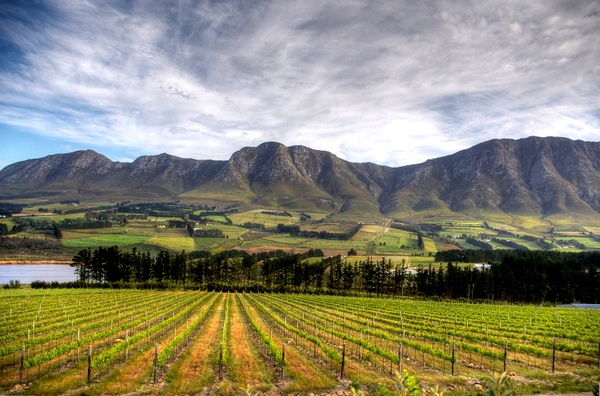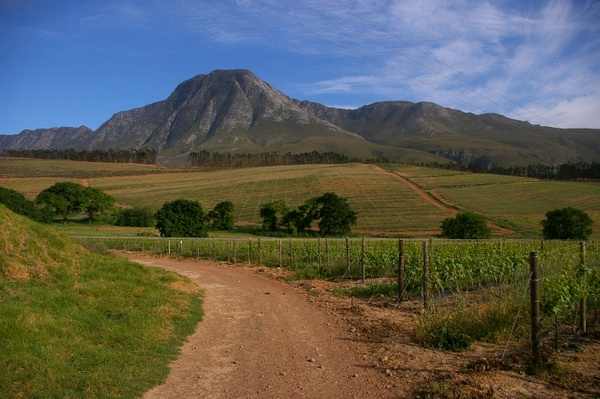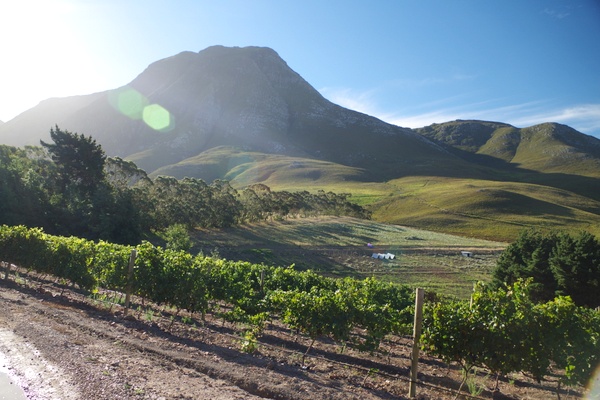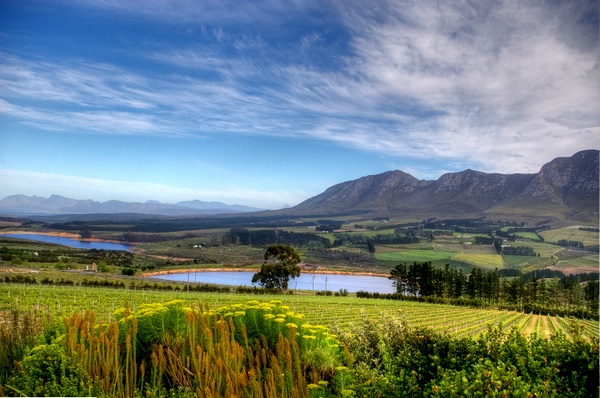|
Introducing
Hemel-en-Arde
Visiting one of South Africa's most interesting wine regions, Hemel-en-Aarde, part 1

‘Heaven on earth’ is the English
translation of Hemel en Aarde,
and this is certainly one of the most beautiful of South Africa’s
wine regions—which, with the stiff competition, is saying
something. The valley stretches inland from the coastal town of
Hermanus, famous for its whale watching. It may be a reasonably long
drive from Cape Town, but you can combine a visit to Hermanus with a
visit to some very pretty wine country. More than worth the effort,
I reckon.
If you haven’t heard of Hemel en Aarde
before, it is probably because this is a fairly new region. The
current appellation names were only implemented as recently as 2006.
Prior to this, the region was known by the name of Walker Bay. But
in 2004, Walker Bay was promoted from Ward status to District. This
left room for the designation of further Wards within the Walker
Bay, and in 2006 two different Hemel en Aarde wards were named. In
2009 a third was added.

This is where it all gets a bit
confusing. Rather than call this whole valley Hemel en Aarde, it has
been split into three, largely on the basis of soil type, but also
with a slice of politics in the mix. As you drive inland from
Hermanus to Caledon along the R320, you will pass through all three
of these appellations.
The nearest bit of the valley to the
coast is called Hemel en Aarde Valley, and this is home turf to the
famous Walker Bay pioneers Hamilton Russell and Bouchard Finlayson.
Soils here are clay-rich Bokkeveld shales, which are distinctive low
vigour soils ideal for the production of quality wines.

Then, travelling further inland, the next
portion is known as the Upper Hemel en Aarde Valley. The soils here
are chiefly composed of Table Mountain sandstone and decomposed
granite, and they can be a bit more fertile. Finally, we have the
third appellation: the Hemel en Aarde Ridge. Depending on who you
talk to, this is technically a different river valley system (Klein
River Valley) and there’s more diurnal variation in temperature
here. It’s the coolest and smallest of the three wards.
The first modern grapevine plantings in
the Hemel en Aarde were in 1976, by Hamilton Russell, and the first
vintage was 1981. ‘We used pretty much all the noble varieties,’
says current proprietor Anthony Hamilton Russell. ‘But we didn’t
have Chardonnay initially. We smuggled Chardonnay in.’ Nowadays,
Hamilton Russell specializes in just Chardonnay and Pinot Noir. They
were joined in 1991 by Peter Finlayson who had been winemaker at
Hamilton Russell for a decade, and then struck out on his own with
Bouchard Finlayson. Both producers are highly respected, and make
some very nice wines.

Over the last few years, winegrowing in
the region has expanded significantly, with lots of newcomers. Many
of them are making great wines.
Hemel en Aarde has a particular talent
for Pinot Noir. ‘Where
Pinot Noir is concerned there have been more accolades and honours
taken from the wineries in the Hemel en Aarde valley than anywhere
else in South Africa,’ says Peter Finlayson. ‘It is a
combination of heavy clay soils with a very soft climate. We are
very fortunate to have the cold ocean running past us and this
moderates temperatures nicely.’
‘Pinot Noir does well here,’ he
states. ‘It is one of the few areas outside Burgundy where one
gets good structure in the Pinot Noirs.’
‘We are incredibly proud that by
accident of fate and terroir our soil and site affords us a chance
to produce unusually classically style Pinot and Chardonnay near the
southern tip of the African continent,’ says Anthony Hamilton
Russell. ‘Our Pinot noir has a degree of savouriness and structure
that goes beyond straight varietal expression. People say it is hard
to work with Pinot Noir. I don’t think it is. It is not how to
make it, but where to make it, and if you get where to make it wrong
then you can try as hard as you like but
it will never be good.’
‘It is an uncomplex variety without
much tannin our colour, but it shines in some sites and transcends
the variety. We are lucky to get that here, with some tannic
structure and depth, a degree of savouriness to augment the
beautiful fruit perfume you can get.’
Peter-Allen Finlayson, of Crystallum,
also thinks the region is well suited to the Burgundy varieties.
‘It’s proving to be THE area for Pinot Noir and Chardonnay in
South Africa,’ he claims. ‘The wines from the area are showing
wonderful minerality and purity of fruit—and elegance. We are new
world, but the wines are less forceful and in your face than a lot
of new world Pinot Noirs and Chardonnays can be.’
This is a cool climate region by South
African standards, and the maritime influence is key to this, with
cool breezes blowing up the valley. Rainfall is higher here than in
many other Cape wine regions, which makes irrigation unnecessary.
But some perspective is added by Kevin Grant of Ataraxia: ‘In the
context of the country we farm in a relatively cool area. But
internationally, we would like to believe we are cool, but this is a
figment of the imagination. Facts show we are not as cool as we
would like to believe.’
I spent a couple of days in the region,
my second visit here, and came away really impressed. There’s a
lot happening here, and the wines are improving fast, in part
through experience, but also with vine age. Here’s a film about
the region, including interviews with some of the key people. Over
the next couple of weeks I will add the producer profiles and
tasting notes.
Visiting Hemel-en-Aarde
 Introduction Introduction
 Bouchard
Finlayson Bouchard
Finlayson
 Newton
Johnson Newton
Johnson
 Hamilton
Russell Hamilton
Russell
 Ataraxia Ataraxia
 Creation Creation
 Crystallum Crystallum
Back
to top
|

